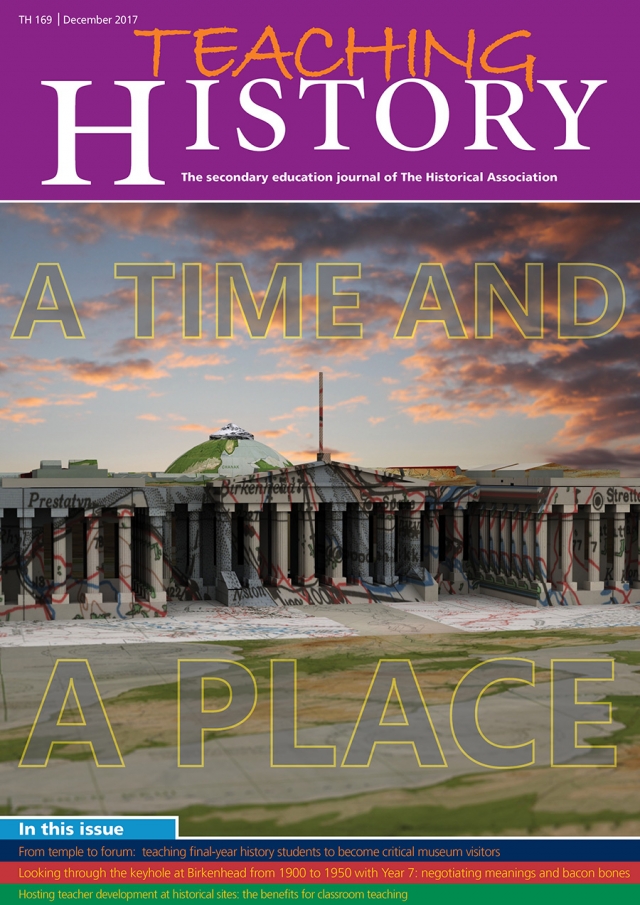Teaching History 169: Out now
Journal news

Access Teaching History 169 here (Free to HA Secondary members)
Editorial: A Time and a Place
The relationship between history and geography in schools is often rather ambivalent. Recent curriculum changes in England have prompted the reconstruction of strong subject boundaries, although many history teachers continue to work alongside their geography colleagues as members of humanities faculties. Relatively few schools (only around 10% according to the latest Historical Association annual survey) compel students to choose between history and geography, but many young people take the decision to pursue one and not the other. As a result, large numbers of those who study history beyond the age of 13 or 14 leave geography behind. The fact that their teachers may well have made the same choice may be partly to blame for the fact that we do not always pay sufficient attention to the importance of place and to the meanings invested in a particular space.
Maps are probably as valuable in teaching history as they are in geography – and not simply for an understanding of the physical features and logistics that inspired, facilitated or constrained any number of political decisions, military campaigns, economic developments or social changes. If students are taught to read them as historical sources, maps also offer invaluable insights into what places have meant to people – and how those meanings have been contested or changed over time. The importance of a sense of place to understanding the past is perhaps most apparent when it has been – or remains – the site of conflict. But even in less obviously controversial circumstances, understanding what a familiar space meant to people in the past, and how such places and/or their meanings changed during the lifetime of particular individuals can also help young people to make meaningful connections between the present and the past.
The places where we encounter history also influence the way in which we think about the past, as Michael Harcourt recognises, in the first article in this issue. Although their scale varies significantly from impressive national institutions to small-scale, sometimes temporary venues, museums and the carefully curated exhibitions that they host are often intended to inspire admiration and respect rather than to provoke critical debate. Harcourt reports on strategies that he used in relation to two new First World War exhibitions to help his students to adopt a more questioning approach. He was particularly interested to explore whether the use of these strategies during a structured school visit would help the young people to adopt a more critical approach when they undertook a more informal visit to the second exhibition. While the impact was not as powerful as he had hoped, Harcourt’s work shows that treating museums as ‘forums’ rather than ‘temples’ can create opportunities for difficult, yet important, conversations about the intersections between history, identity and power.
It is the conversations that it opened up that makes Michael Bird and Matt Jones’s focus on local history particularly interesting. Teaching in Birkenhead, Jones chose to focus an enquiry on the reasons why a local estate, well-known to his students, had been built in the 1940s. He hoped that by tracking the history of six families, first encountered in the census of 1901, his students would gain a much deeper insight into the impact on people’s lives of the two world wars and the Great Depression of the 1930s. While the students were undoubtedly hooked by the personal stories, Bird was surprised by their questions and preoccupations and by the way in which even relatively recent changes in their local area had so quickly obscured aspects of its past with which he had expected the students to be familiar. The article illustrates the importance of giving young people time to articulate their questions, rather than simply assuming that they have mastered the learning objectives prescribed for them.
Edward FitzGerald also uses personal stories to engage students’ interest, dealing in this case with contested territories in which participants’ specific location interacts with their sense of religious and political identity. Building on previous teachers’ work with character cards as a means of helping students to deal with the concept of similarity and difference, FitzGerald illustrates how careful use of historical scholarship can help GCSE students to move beyond simplistic generalisations and naïve characterisations of difference.
While the importance of place as well as time has been formally recognised by the inclusion of the ‘historic environment’ within the national GCSE requirements, there is no obligation for students to visit the sites about which they are learning. While this certainly does not mean giving up on local history (which remains a feature of the National Curriculum at Key Stages 2 and 3) Adam Burns and Carmel Bones both acknowledge the need to make particular sites meaningful to students who may not be able to explore them for themselves. While Burns demonstrates the value of teachers’ own extended visits, enriched by expert input and access to local archival sources, Bones draws enthusiastically in her Triumphs Show on the power of Virtual Reality.
The way that place becomes imbued with meaning through the events that have taken place there is central to Verity Morgan’s approach to teaching the Holocaust. Drawing on recent research into the landscapes of the Holocaust her article illustrates the value of an environmental approach to teaching sensitive and controversial issues. Michael McIntyre and Vanessa Hull also focus on the Holocaust, outlining strategies that teachers might use to help young people to make connections between actions that took place at a specific time and place and their own world today. Their aim is to encourage young people to use their knowledge of the past to think carefully about the decisions they make in the present and about the role that they can play.

